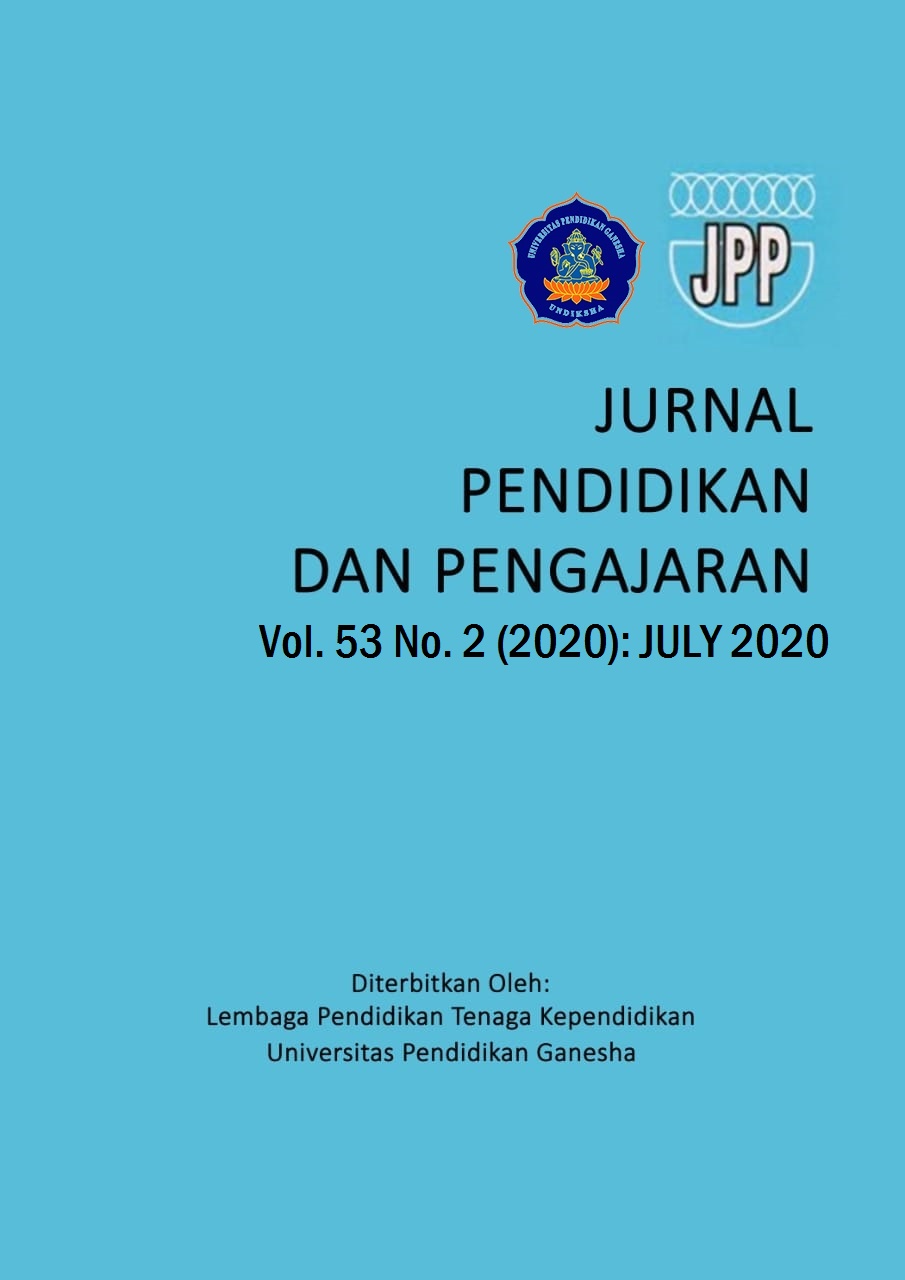Teachers' Readiness in Inserting the 21st Century Skills in the Lesson Plan in Teaching English
DOI:
https://doi.org/10.23887/jpp.v53i2.26406Keywords:
21st-century skills, insertion, readinessAbstract
The 21st-century learning outcomes are essential to be achieved by the students nowadays. A lesson plan is one of the mediums used to insert the skills of the 21st century, which needed to be improved by the students. This study examined English teachers’ readiness in inserting the 21st-century skills in planning the lesson in the city area and suburb area of Badung Regency. This study belonged to a case study and was conducted using a sequential embedded mixed-method, in which mixed the quantitative results with qualitative results to get more valid data. A questionnaire consisted of 17 items used to know the readiness of English teachers, combined with the results on document analysis. Based on the results of the investigation, it showed inconsistent answers of English teachers in the city area and suburb area based on the results on questionnaire and document analysis. English teachers perceived they were ready to insert the 21st-century skills but, based on results on document analysis, it showed English teachers mostly added learning and innovation skills and information, media, and technology skills in the lesson plan. It is suggested English teachers should be more ready by looking up at the standardization of the 21st-century education then combined it with attending seminars on related topics about the implementation of the 21st-century skills.
References
Ahmad, D. (2014). Understanding the 2013 curriculum of English teachers through the teachers’ and policymakers’ perspectives. International Journal of Enhanced Research in Educational Development, 2(4), 2320–87086.
Alismail, H. A., & McGuire, P. (2015). 21st Century standards and curriculum: current research and practice. Journal of Education and Practice, 6(6), 150–155.
BussinessDictionary.com. (2020). Readiness. Investors Words.
Candiasa, I. M. (2010). Statistik univariat and bivariat disertai aplikasi SPSS. Unit Penerbitan Universitas Pendidikan Ganesha.
Gallego, M. R. R. (2014). Lesson planning in primary and secondary education. Research Gate, January 2007.
Ginanjar, G. G., & Suhadi, M. (2018). Femininities and masculinities depiction: A critical discourse analysis. Pancaran Pendidikan, 7(2), 125–132. https://doi.org/10.25037/pancaran.v7i2.163
Hady, W. R. A. Bin, & Abdulsafi, A. S. T. (2018). How can I prepare an ideal lesson plan? 1(4).
Handayani, N. (2017). Becoming the effective English teachers in the 21st century: What should know and what should do? 1st English Language and Literature International Conference (ELLiC), 6 May, 2017, 156–164.
Harjanti, M. H. (2018). The implementation of the 21th century competency for elementary school teachers at curriculum 2013 training central java province year 2017. 1(Snpd), 523–531.
Hashim, Y. (2014). 21st century education: are we heading towards the right direction of improving teaching and learning as needed by educational transformation programme. 8th International Malaysian Educational Technology Convention 2014, October, 1–21.
Idaho Department of Education. (2016). 21st century classroom lesson plan. Idaho Preferred, 3–10.
Menggo, S., Suastra, I. M., Budiarsa, M., & Padmadewi, N. N. (2019). Needs analysis of academic-English speaking material in promoting 21 st century skills. International Journal of Instruction, 12(2), 739–754. https://doi.org/10.29333/iji.2019.12247a
Pacific Policy Research Center. (2010). 21st century skills for students and teachers. Kamehameha Schools, Research & Evaluation Division.
Padmadewi, N. N., Artini, L., & Putu Kerti Nitiasih, P. (2018). Techniques for building character and literacy for 21st century education. May. https://doi.org/10.2991/icei-17.2018.65
Pam, M. S. N. (2013). What is readiness. Psychology Dictionary.
Partnership for 21st Century learning. (2015). 21st century students outcomes. 1–9.
Purwadhi. (2019). Curriculum management in the 21st century learning. SOSIOHUMANIKA: Jurnal Pendidikan Sains Sosial Dan Kemanusiaan, 12(1), 143–156.
Riadi, A. (2019). An empirical studies on Indonesian English-curriculum changes: opportunities and constraints in an underdeveloped region. Indonesian TESOL Journal, 1(2). https://doi.org/10.24256/itj.v1i2.835
Rusdin, N. M. (2018). Teachers’ readiness in implementing 21st century learning. International Journal of Academic Research in Business and Social Sciences, 8(4), 1293–1306. https://doi.org/10.6007/ijarbss/v8-i4/4270
Syamsuri, H. A. S., & Ishaq. (2010). Makalah : guru, generasi Z, dan pembelajaran abad 21. Repositori Unismuh.Ac.Id, 1–15.
Trilling, B., & Fadel, C. (2009). 21st century learning skill: learning for life in our time (first edit). Jossey-Bass A Wiley Imprins.
Valli, P., Perkkilä, P., & Valli‡, R. (2013). Adult pre-service teachers applying 21st century skills in the practice. 1(2), 115–130.
Widyanti, N. W., Santosa, M. H., & Utami, I. G. A. L. P. (2019). Impeding factors faced by the english teachers in implementing technological pedagogical content knowledge framework in teaching at senior high schools in buleleng sub-district. Language and Education Journal Undiksha, 2(1), 38–42.
Yulianto, B., Kamidjan, Ahmadi, A., & Asteria, P. V. (2018). Development of short Indonesian lesson plan to improve teacher performance. IOP Conference Series: Materials Science and Engineering, 296(1). https://doi.org/10.1088/1757-899X/296/1/012001
Zubaidah, S. (2016). Keterampilan abad Ke-21: keterampilan yang diajarkan melalui pembelajaran. Seminar Nasional Pendidikan, 2(2), 1–17. https://doi.org/10.1021/acs.langmuir.6b02842
Downloads
Published
How to Cite
Issue
Section
License
Authors who publish with Jurnal Pendidikan dan Pengajaran agree to the following terms:- Authors retain copyright and grant the journal the right of first publication with the work simultaneously licensed under a Creative Commons Attribution License (CC BY-SA 4.0) that allows others to share the work with an acknowledgment of the work's authorship and initial publication in this journal
- Authors are able to enter into separate, additional contractual arrangements for the non-exclusive distribution of the journal's published version of the work (e.g., post it to an institutional repository or publish it in a book), with an acknowledgment of its initial publication in this journal.
- Authors are permitted and encouraged to post their work online (e.g., in institutional repositories or on their website) prior to and during the submission process, as it can lead to productive exchanges, as well as earlier and greater citation of published work. (See The Effect of Open Access)





